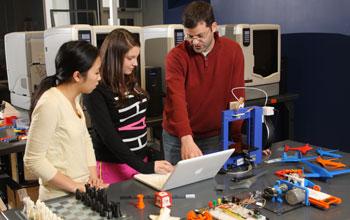Hexa Research Makes Projections for 3D Printing into 2020, Lack of Skill Sets May Impede Progression
 Rocket thrusters. Microscopic art. . Complex face transplantation. Allowing us to innovate in an incredibly complex manner, the benefits of 3D printing are deceptively simple–and definitely undeniable. We can do what we’ve never done before. Check. We can do it faster, better, and with much less waste. Triple check. We can do it more affordably–meaning bigger checks all around in business. And while all of these ‘pros’ point toward a clear superiority over traditional methods, in many cases too we’ve learned that 3D printing and conventional processes can be combined with spectacular, complementary results.
Rocket thrusters. Microscopic art. . Complex face transplantation. Allowing us to innovate in an incredibly complex manner, the benefits of 3D printing are deceptively simple–and definitely undeniable. We can do what we’ve never done before. Check. We can do it faster, better, and with much less waste. Triple check. We can do it more affordably–meaning bigger checks all around in business. And while all of these ‘pros’ point toward a clear superiority over traditional methods, in many cases too we’ve learned that 3D printing and conventional processes can be combined with spectacular, complementary results.
All of this has been summarily pointed out in recent analysis by Hexa Research in 3D Printing Market Analysis By Application (Automotive, Aerospace, Aerospace, Medical), By Raw Material (Polymers, Metals, Ceramic) And Segment Forecasts To 2020, and then some. As the global market research and consulting organization counts the ways in which we love this substantial technology, they also point out one main troubling factor that may pose a significant hurdle to progress. We’re talking education. While many are working diligently on solutions–is it enough?
“The technology demands for easier accessibility and training practice which is necessary to avail more advantages and to make efficient use of technology,” states the analysis. “This factor has projected as a challenge to the growth of the market over the forecast period.”
 From figuring out how to operate that desktop 3D printer that just arrived on the doorstep to the more complicated area of designing 3D printing curricula and churning out enough graduates with the correct skill sets to take jobs waiting for people to fill them, Hexa researchers project that the major stumbling block may be in the learning curve. Their study shows that still, 3D printing needs to become more accessible and user-friendly–a mantra that’s been the common chant at all levels, coming from industry titans to small, progressive startups centered around giving 3D printing power to the people.
From figuring out how to operate that desktop 3D printer that just arrived on the doorstep to the more complicated area of designing 3D printing curricula and churning out enough graduates with the correct skill sets to take jobs waiting for people to fill them, Hexa researchers project that the major stumbling block may be in the learning curve. Their study shows that still, 3D printing needs to become more accessible and user-friendly–a mantra that’s been the common chant at all levels, coming from industry titans to small, progressive startups centered around giving 3D printing power to the people.
“The major advantage of 3D technology is to obtain a product which is not easily manufactured otherwise,” states the Hexa Research team.
This is projected to continue in applications where we are already seeing 3D printing take a foothold, and still with the highest percentage of 3D printing activity taking place in the US. We will see other countries begin to gain steam in using the technology to further their economies however.
“North America is the largest regional market of 3D printing, due to the existence of major players of 3D printing technology in this region,” states the analysis. “Stratasys and 3D Systems are the major players in North America.3D printing market. These companies are expected to grow gradually in Europe over the forecast period owing to the increasing awareness about 3D printing technology.”
“In Asia Pacific, Japan is the largest regional market which is going to witness significant growth in coming years due to the increasing demand of consumer goods as well as existing favourable aspects for manufacturing and sales of the 3D printers. Chinese government is expected to focus on creating high value finished products which can lead to the growth of the 3D printing market in near future.”
Overall, it’s no surprise that analysts see 3D printing benefiting sectors in the future such as:
- Automotive – for tooling, low-volume parts, and prototyping
- Aerospace – for tooling, part manufacturing, and prototyping
- Consumer products – for fabricating new designs and patterns, with prototypes created by industrial designers and artists
- Medical applications – in making hearing aids, prosthetics, dental objects, knee joints, engineered tissue and furthering strides in bioprinting
“Mechanical engineers, industrial designers, graphic artists and packaging designers use prototypes designed with the help of 3D printing to understand product’s aesthetic and its functional appeal which is going to impact the market growth positively over the forecast period,” state the analysts.
Examining materials, it’s projected that polymers will retain their place as the number one raw material used in 3D printing, and that use will increase. Metal 3D printing, as we see trending strongly now, is expected to be on the rise in manufacturing, with the use of metals such as chromium, titanium, aluminum, and cobalt. These specific processes are expected to be continually refined and used further in areas such as aerospace, automotive, and electronics consumer goods.
As 3D printing marches forward as a prized technology and more and more competitors jump into the game, it’s logical to expect that prices may come down all around, but Hexa Research points out–and this has certainly been the case up until now as well–that intellectual property issues may create another barrier.
The technology titans we are already familiar with such as Stratasys and 3D Systems are expected to maintain their hold on the market and continue contributing, along with others like Arcam, CRP Group, EnvisionTEC, Royal DSM, Arkema, LPW Technology, EOS, Oxford Performance Materials, ExOne, Hoganas, voxeljet, and Materialise.
Using a process for fabrication that is quite straightforward, ingenious humans have been able to make progress in very complex areas, from innovative components that will help us in space travel, to bioprinting, making cellular structures that one day will lead to 3D printed organs and facilitate seamless transplants. While analysis, projections, and studies shed great light on what could happen, it will be interesting to see how the maker community evolves further as well as what happens within several of the larger 3D printing manufacturer’s corporate layers.
Anything could happen within the 3D printing industry, as it is led by innovation and creativity. With a future of infinite options ahead, it’s a sure bet that we can look forward to new products which are completely unimaginable in this moment. Will the lack of skill ultimately impede the progress being made within this space? Let’s hear your thoughts in the Hexa Research Forum thread on 3DPB.com.
Subscribe to Our Email Newsletter
Stay up-to-date on all the latest news from the 3D printing industry and receive information and offers from third party vendors.
You May Also Like
3D Printing Unpeeled: New Arkema Material for HP, Saddle and Macro MEMS
A new Arkema material for MJF is said to reduce costs per part by up to 25% and have an 85% reusability ratio. HP 3D HR PA 12 S has been...
3D Printing News Briefs, January 20, 2024: FDM, LPBF, Underwater 3D Printer, Racing, & More
We’re starting off with a process certification in today’s 3D Printing News Briefs, and then moving on to research about solute trapping, laser powder bed fusion, and then moving on...
3D Printing Webinar and Event Roundup: December 3, 2023
We’ve got plenty of events and webinars coming up for you this week! Quickparts is having a Manufacturing Roadshow, America Makes is holding a Member Town Hall, Stratafest makes two...
Formnext 2023 Day Three: Slam Dunk
I’m high—high on trade show. I’ve met numerous new faces and reconnected with old friends, creating an absolutely wonderful atmosphere. The excitement is palpable over several emerging developments. The high...

































